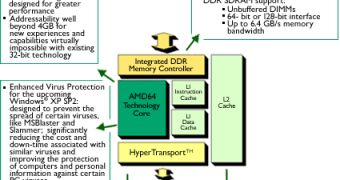Parallel computing is nothing new as it has been around for years in different shapes and sizes from the true model of parallel execution available on mainframes, servers and other multi processor systems to the quasi parallel version based on time sharing and thread shifting that is implemented into the single processor computers. As multi core processors become more affordable and so more popular, even uni processor computers will receive a degree of true parallel computing capabilities. AMD is pressured to expand its base product offerings if it wishes to be able to continue its market presence while its bigger rival releases a new processor every few months, sometimes even less. So while AMD cannot beat Intel at releasing times and quantities, it plans to boost the parallel computing performance of its processors by adding some specialized hardware instructions.
The "Light-Weight Profiling" (LWP for short) specifications deal exactly with AMD's performance increase in parallel computing and according to the news site RegDeveloper, the chip manufacturing company said that the parallel computing technology explained in the LWP specifications report is very similar to the hardware hooks that are used for enhanced virtualization support, with the notable exception that LWP's instructions will be used to move runtimes and other components more efficiently across different cores. As the processor industry shifted from a single powerful core on a chip to several slower cores on the same chip, the entire software industry remained behind and they now have to reorient themselves towards multi-threaded applications in order to receive the full benefits of the underlying hardware.
"The LWP specification describes the first technology that supports a recently introduced initiative called 'Hardware Extensions for Software Parallelism,' which will encompass a broad set of innovations designed to improve software parallelism, and thus application performance, through new hardware features in future versions of AMD processors," AMD said. "LWP is a CPU mechanism that could have broad benefit to software including, but not limited to, runtime environments such as Sun Microsystems' Java Virtual Machine and Microsoft's .NET Framework."
Apart from the instruction set aimed at parallel computing, it is rumored that AMD plans for instructions that would boost performance in transactional memory and high performance message passing. Instructions found in the LWP specification are covering the basic aspects like turning on and off and low level information gathering.

 14 DAY TRIAL //
14 DAY TRIAL //